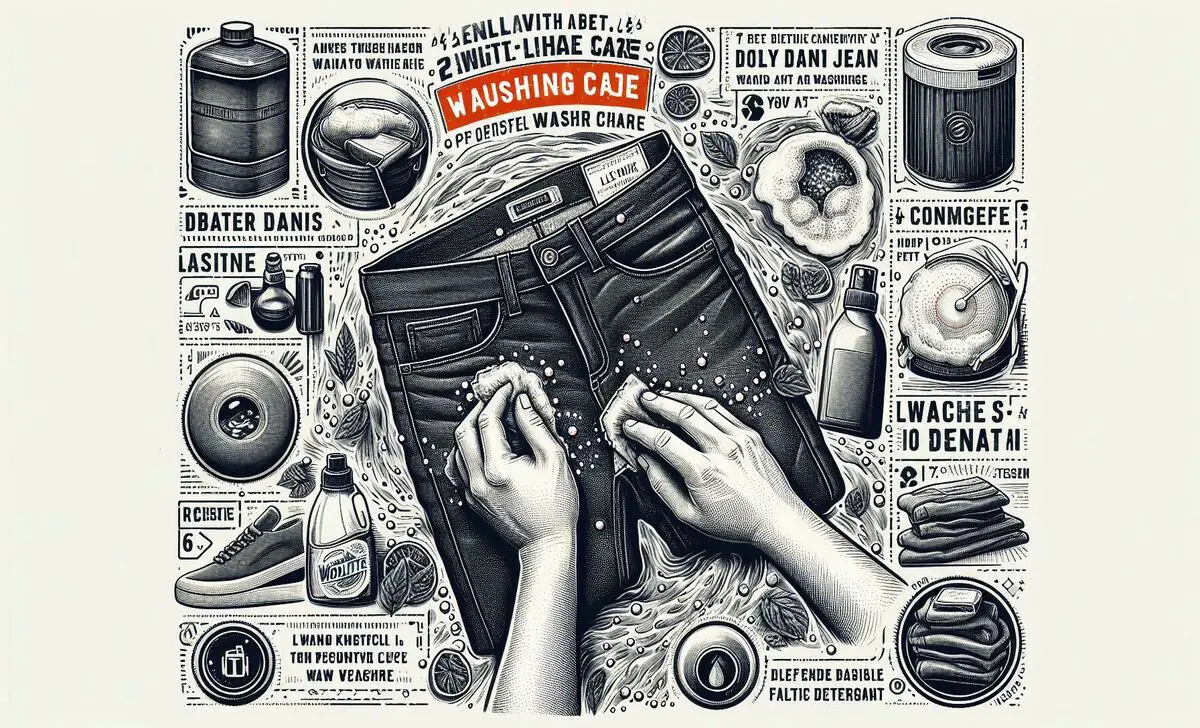Washing jeans properly in a washing machine is crucial for maintaining their longevity and appearance. Jeans are a staple in many wardrobes, and proper care ensures they stay looking great for years. The right washing techniques can help prevent fading, shrinkage, and damage to the fabric.
To achieve the best results, it’s important to follow specific steps when laundering your jeans. This includes selecting the appropriate water temperature, using the right detergent, and choosing the correct washing cycle. By adhering to these guidelines, you can preserve the colour, fit, and overall quality of your jeans, keeping them in excellent condition through countless washes.

Tips To Wash Jeans In Washing Machine For Optimal Care

Washing jeans in a washing machine requires careful attention to detail to ensure optimal care and longevity. This can be straightforward, but ensuring they stay in top condition requires a bit of extra care.
Proper washing techniques not only help maintain the fabric’s integrity but also preserve the color and fit of your jeans. This approach helps preserve the fit and appearance of your jeans, keeping them in excellent condition over time. Here are some essential tips for washing jeans in the machine to achieve optimal care.
Preparation
Proper preparation is key to ensuring your jeans remain clean and maintain their colour and fabric quality. First, sort your jeans by colour, separating light jeans from dark ones. For example, keep your clean jeans and black jeans in separate piles. Additionally, turn each pair inside out before washing. This simple step helps protect the fabric and preserve the colour, preventing fading.
Before placing your jeans in the washing machine, it’s wise to apply a stain remover to any visible stains. Allow the stain remover to sit for a few minutes to penetrate the fabric and effectively lift the stains. Once your jeans are ready for the wash, use a suitable laundry detergent that is designed for denim.
Choosing The Right Settings

Selecting the correct washing machine settings is essential for preserving the quality of your denim fabric. Whether you’re washing new jeans or your favorite denim jacket, proper settings help maintain the color and fit of your jeans. Choosing a gentle or delicate cycle minimizes agitation, which helps protect the fabric from wear and tear. This careful approach ensures your jeans remain in top condition, regardless of how often they are washed.
- Water Temperature: Use cold water to prevent shrinking and fading.
- Wash Cycle: Select a gentle or delicate cycle to minimize wear and tear.
Detergent And Additives
Opt for a mild detergent specifically designed for delicate fabrics. This will help safeguard the integrity of the denim and keep your jeans looking fresh. Use liquid detergent to ensure even distribution and avoid the potential for residue that powder detergent can leave. For dark jeans, opt for a detergent designed for dark colours to preserve their hue
If you choose to use fabric softener, do so sparingly, as excessive use can alter the texture and colour of your jeans over time. Remember, it’s best to wash jeans in the laundry only when necessary—frequent washing can lead to wear and tear.
Washing Process

Preparing jeans for washing in a washing machine is essential. Set your washing machine to use warm water, as this helps to clean the jeans thoroughly while minimizing shrinkage. Spot-clean any noticeable stains before washing to ensure they are addressed effectively.
Tips:
- Loading the Machine: Avoid overloading; ensure there’s enough space for the jeans to move freely.
- Running the Cycle: Start the machine and let it complete the wash cycle.
- Excess Water: Consider using the spin cycle to remove excess water, reducing drying time.
Drying
After washing denim garments in a machine, drying is crucial for maintaining their shape and fit. While hand washing is gentle, machine washing is common for convenience, but it requires careful drying to preserve the quality of your jeans. Air drying is highly recommended as it helps prevent shrinkage and maintains the original fit of the jeans.
If you choose to machine dry, opt for a low heat setting and remove the jeans while they are still slightly damp to minimize heat damage and distortion. Proper drying ensures that your jeans, including those with ripped details or stretch denim, remain in excellent condition and retain their intended appearance.
- Air Drying: Hang jeans in a well-ventilated area to prevent shrinkage and maintain fit.
- Machine Drying: Use a low heat setting and remove jeans while slightly damp to reduce heat damage.
Post-Wash Care

Post-wash care is an essential part of maintaining the quality and longevity of your jeans, especially after washing them in a washing machine. To begin with, always check the fabric care label on your jeans for specific washing instructions. For raw denim jeans, it’s crucial to wash them in cool water to prevent fading and shrinking.
Using a gentle detergent, such as Woolite Dark, can help preserve the color and texture of your dark denim, ensuring they remain vibrant over time. If necessary, after washing, you may need to iron your jeans.
It is advisable to iron them on a low setting while they are still slightly damp; this will make the process easier and help achieve a smooth finish without applying too much heat, which can damage the fabric. When it comes to storage, you should keep your jeans in a cool, dry place. Folding or hanging them properly is important to retain their shape and prevent creasing.
Conclusion
Properly washing jeans in a washing machine is essential to maintaining their quality and prolonging their lifespan. By following the recommended steps- turning jeans inside out, using cold water, selecting a gentle cycle, and air drying or using a low heat setting in the dryer- you can prevent color fading, shrinkage, and damage to the fabric.
Taking these precautions helps keep your jeans looking their best and ensures they remain a staple in your wardrobe for years to come. Remember, investing a little extra time and care into washing your jeans will pay off in the long run, preserving their fit and appearance.
FAQs
1.How Often Should I Wash My Jeans?
It is generally recommended to wash jeans every 4-6 wears to preserve their color and fit. This helps maintain the quality of your favorite jeans and prevents excessive wear from frequent washing.
2.Can I Use Bleach On My Jeans?
Avoid using bleach on jeans as it can cause discoloration and weaken the fabric. Instead, opt for a gentle detergent to keep your jeans looking their best.
3.What Should I Do If My Jeans Bleed Color?
Wash them separately or with similar colors to avoid transferring dye. Adding a cup of white vinegar to the wash can help set the color and reduce bleeding. This is especially useful for dark or new jeans.
4.Is It Okay To Dry Jeans In The Dryer?
While air drying is preferable, you can use a dryer on a low heat setting if necessary. Remove jeans while still slightly damp to prevent shrinkage and maintain the fabric’s integrity.
5.Can I Wash Jeans With Other Clothes?
It’s best to wash jeans with similar colors and fabric types to avoid damage and dye transfer. Mixing them with delicate fabrics or light-colored items can lead to unwanted stains or fabric wear.
6.Should I Button And Zip My Jeans Before Washing Them?
Yes, buttoning and zipping jeans help them maintain their shape and prevent other clothing from snagging on them. This practice also protects the zippers and buttons during the wash cycle.
7.What If My Jeans Have A Strong Odor?
To eliminate odors, soak jeans in a mixture of water and white vinegar before washing, or use a detergent designed for odor removal. For persistent odors, consider a hand wash with a special odor-fighting solution.
8.Can I Hand Wash Jeans?
Yes, hand washing jeans is a gentle way to clean them, especially for delicate or ripped jeans. Use cold water and a mild detergent, and avoid wringing out the fabric to preserve its shape and color.
9.Should I Use Hot Water To Wash Jeans?
Avoid using hot water, as it can cause jeans to shrink and fade. Instead, cold or lukewarm water is used for washing to maintain the fabric’s quality and color.











